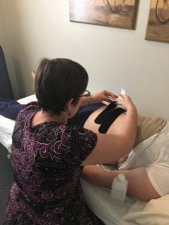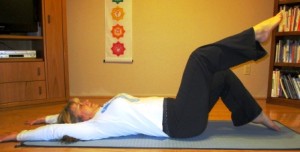Your pelvic floor health can be improved with the breath, body, and mind practices of yoga. I have practiced and trained in yoga for pelvic floor health across the life span and integrate material into all classes. Much of what I teach in prenatal yoga supports moms-to-be in body/mind/breath awareness during pregnancy.
Yogic practices can also prevent future pelvic floor and core recovery issues once baby arrives. In this article, we learned about prenatal yoga and physical therapy to support pelvic health during pregnancy. This same awareness as well as specific yogic therapeutic practices appy to post-partum recovery.

Gratitude to the talented PTs at Bodycentral Physical Therapy for your thoughtful and helpful responses: Doctors Maria, Madeleine, and Sarah for their contributions to this article and Doctor Melissa and Client Jessica for allowing Shannon to share photos.
We partner in being supporters, providers, and advocates for our students’ health and well being.
Let’s dive into post-partum pelvic floor health, yoga, and PT:
What kind of issues do women have after birth for which a physical therapist is trained to help?
Postpartum care can include a myriad of diagnoses. All can be assessed through physical therapy and properly assigned exercises to improve mobility and function and to relieve pain.
- Coccydynia is inflammation of the tailbone caused by relaxin’s effect on the pelvic floor muscles or by the baby passing through the birth canal.
- Diastasis Recti is a fairly common condition of pregnancy and postpartum in which the right and left halves of Rectus Abdominis muscle spread apart. This condition can lead to lower back pain, incontinence, pelvic organ prolapse, and even painful intercourse.
- Incontinence(both fecal and urinary), frequent urination, nocturia (excessive voiding at night), and fecal urgency can all be caused by pregnancy and birth, whether vaginal or cesarean.
- Dyspareunia(painful intercourse) can be caused by hormone imbalance or lingering pelvic floor issues. Cesarean birth and vacuum assisted birth both make this issue twice as likely to occur.
- Sciatica and Back, Hip, or Pelvic Pain may linger after birth or be caused by the work birth

The PT recommendations described below are also included in our Yoga offerings:
Although there is no “one-size-fits-all” treatment because every woman is different, most women can benefit from transverse abdominus strengthening along with pelvic floor conditioning. Gentle stretching to relieve achiness caused by breastfeeding, holding a new baby, or lugging around a carseat is beneficial. Resting whenever possible and using relaxation techniques are wonderful for tuning back in with yourself and your body, which is often lost when constantly caring for a newborn.

According to Dr. Melissa Buss:
Yoga is one of the best preventative and complementary treatments with pelvic floor therapy, for several reasons.
It makes a world of difference. Learning to breath again is something taught to our patients, but one hour a week isn’t going to do it.
We rely on you and other well trained yoga instructors to help patients with the reinforcement!”
We would love to spend hours with each patient going over postures and stretches to ease daily activity motion but simply don’t have the time.
Yoga, if well taught, includes multiple movements that are good for the body and the soul. We are big proponents of appropriate live yoga classes instead of an at-home program; no one is watching you to correct alignment or give verbal cues on how you can deepen the stretch.

Why might it be important to see a physical therapist after baby is born?
Birthing causes trauma to tissues just like any other injury or surgery. Many times, after a birth (either vaginal or cesarean), muscles, ligaments, pelvic alignment, and tissues can be irritated or in a state of dysfunction.
Without assistance of pelvic floor therapy, dysfunctions can continue years after birth. Leaking urine when jumping or sneezing, while common, is not normal for a postpartum body. It generally means there is an underlying issue with the coordination and/or strength of the pelvic floor muscles.
There are also the potential added challenges of scarring, tissue asymmetry, pelvic alignment, and posturing dysfunctions.
These all can be assessed after birth which allow the new mother to rehabilitate her body in order to strengthen and stabilize the pelvis to reduce long lasting effects or complaints.
Further Reading:
Prenatal Yoga, PT and Pelvic Floor Health
Menopause Yoga and PT and Pelvic Floor Health


2 Comments
Thanks. It was helpful.
Excellent! I’m so glad it was for you, Sophia.
Comments are closed.